Be Antibiotic Aware Campaign
CDC and ATSDR Health Message Testing System
Att 5 - Mod Guide for SS Women_EN
Be Antibiotic Aware Campaign
OMB: 0920-0572
Form Approved
OMB Control No.: 0920-0572
Expiration date: XX/XX/XXXX
FINAL – DHQP and NCEZID cleared.
Antibiotic Use Campaign – Moderator Guide
Consumers—Spanish-Speaking Women, 26–64 years old
WELCOME, OVERVIEW, AND RULES [5 MINUTES]
Welcome and thank you for agreeing to participate in this focus group. My name is __________ and my role is to guide the discussion. I’m not an expert in the topic we’ll discuss, so I have no particular agenda or point of view. I work for ICF, a private research organization. The Centers for Disease Control and Prevention, or CDC, is sponsoring this health communication initiative. I did not develop any of the messages you will be seeing so I want to get your honest and frank opinions about them.
The purpose of this focus group is to hear your views and opinions on important health topics about antibiotic use. We will also ask for your feedback on a few materials. Your insights are very important to us. CDC will use your feedback to improve the materials you will see. Your time today is appreciated. We will have about an hour and 15 minutes for our discussion.
Before we begin, I want to point out a few things:
Most importantly, there are no “right” or “wrong” answers to the questions I’m going to ask. Please relax and enjoy the discussion.
We are recording this discussion to ensure that we collect all the information that is provided. I want to give you my full attention and not have to take a lot of notes. I have to write a report about our discussion. I will refer to the recording when writing the report.
Also, some of the people working on this project are observing or listening to this discussion.
Everything you have to say will be kept private and any identifying information will be removed from reports and other data. While those of us here today know your name, only the facility knows your address and phone number, and this information will not be given to anyone and no one will contact you after this focus group is over.
We may share information learned from these discussions in documents or materials like reports, conference presentations or posters, or publications. We may also share the information with other health departments and organizations to help their work to improve antibiotic use. Please know that the information you share will not be linked to your name or any other identifying information.
If at any time you are uncomfortable with my questions, you can choose not to answer. Simply let me know that you prefer not to answer. Your participation in this project is completely voluntary.
Be sure to only use first names during the discussion or use a made-up name, if you prefer. Please do not use your last name. Also, if you bring up a friend or other person you know as an example in our discussions, please do not use their last name either. So, whenever you mention a name, it should only be a first name and never a last name.
Finally, a few requests before we begin:
Please respect the other participants’ opinions.
Please maintain privacy - what is said here remains here.
Please speak one at a time.
Please turn off your cell phone or put it in vibrate or silent mode.
And as mentioned when you were recruited to participate, you will receive a token of appreciation for participating. At the end, there will be a few minutes to address questions you may have about antibiotic use with a CDC team member.
Do you have any questions before we get started?
GENERAL KNOWLEDGE OF ANTIBIOTICS AND SOURCES OF INFORMATION ABOUT ANTIBIOTICS [10 MINUTES]
Ok, let’s get started. First, I’m going to ask you a few general questions about antibiotics and where you go to get information about them.
What do you know about antibiotics?
PROBE: When should and shouldn’t they be used?
PROBE: What do they treat?
PROBE: What are your feelings about taking them?
Where do you usually get your information about antibiotics? (HMTS 69d)
PROBE: What about healthcare providers? Which ones?
PROBE: What websites, if any, do you go to for information about antibiotics?
PROBE: What other media sources do you use to get information about antibiotics? [Prompt: This can include TV shows, radio programs, podcasts, etc.]
PROBE: Why do you choose to get your information from these sources?
PROBE: Is it because you trust them, or because they are convenient? Why?
What organizations, if any, do you trust as a reliable source of information about antibiotics? (HMTS 74d)
PROBE: Why do you trust these organizations?
Have you ever seen, heard, or read any TV, radio, newspaper, or online advertising about Be Antibiotics Aware?
PROBE: [If yes] Where have you seen or hear about Be Antibiotics Aware: on TV? on social media? through email? on a website?
CONDITIONS ANTIBIOTICS DO AND DON’T TREAT – TESTING CURRENT CDC MESSAGING [10 MINUTES]
In the last few minutes you all told me what antibiotics can and cannot treat and where you get information about antibiotics. Let’s move on to our first material. Take a few minutes to read this material and then we’ll discuss it.
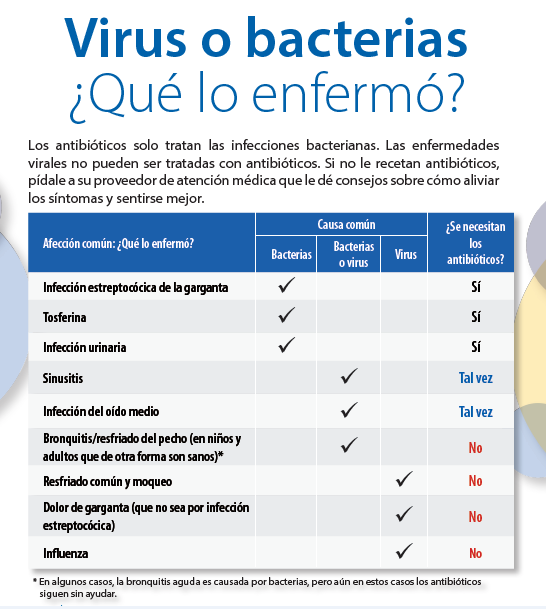
https://www.cdc.gov/antibiotic-use/community/sp/downloads/virus-bacteria-chart.pdf
What would you say is the main message of this material? (HMTS 1d)
Are these new ideas or something you have heard before? (HMTS 12d)
PROBE: If you’ve heard this information before, where have you heard it?
PROBE: [If new] How does this new knowledge impact the way you think about antibiotics?
What information in this chart, if any, is confusing, unclear, or hard to understand? (HMTS 6d)
Are there any words that were unusual or unfamiliar? (HMTS 4d)
PROBE: [If yes], which words are unusual or unfamiliar to you?
What, if anything, do you want to know that this chart doesn’t tell you? (HMTS 29d)
PROBE: What other illnesses, if any, do you think should be included on this chart?
Now I have a few questions about the visual aspects of the piece.
Overall, how appealing is this material to you? (HMTS 7e)
PROBE: Why?
Where would you expect to see this material? (HMTS 9e)
PROBE: What about social media?
PROBE: In your doctor’s office?
Is there anything about the material that you really don’t like?
PROBE: Why?
RISKS OF ANTIBIOTICS – TESTING CURRENT CDC MESSAGING [20 MINUTES]
Ok, let’s move on to our second material. Please take a few minutes to read through it before I ask questions (give 4-5 minutes).
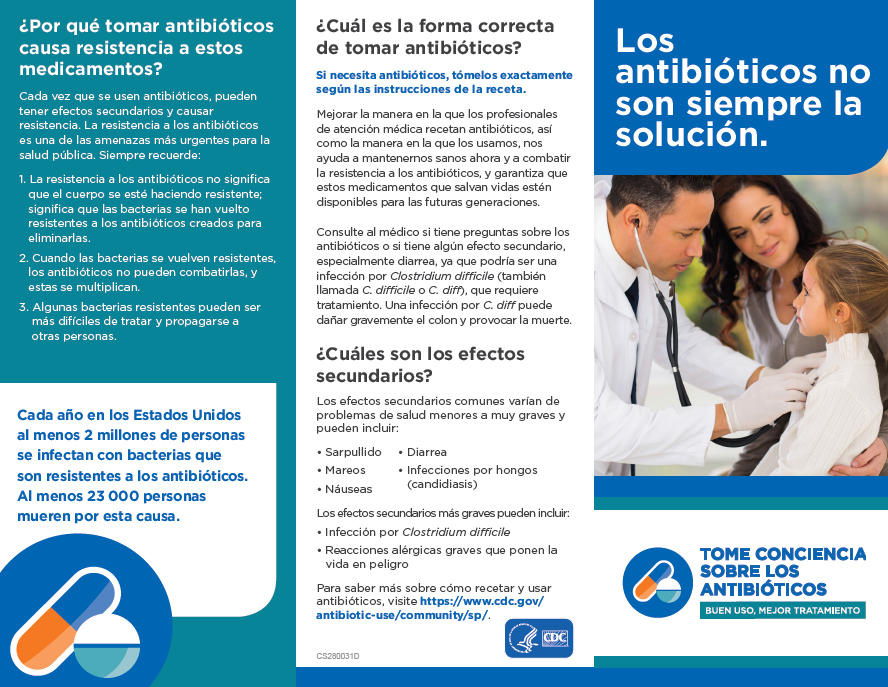
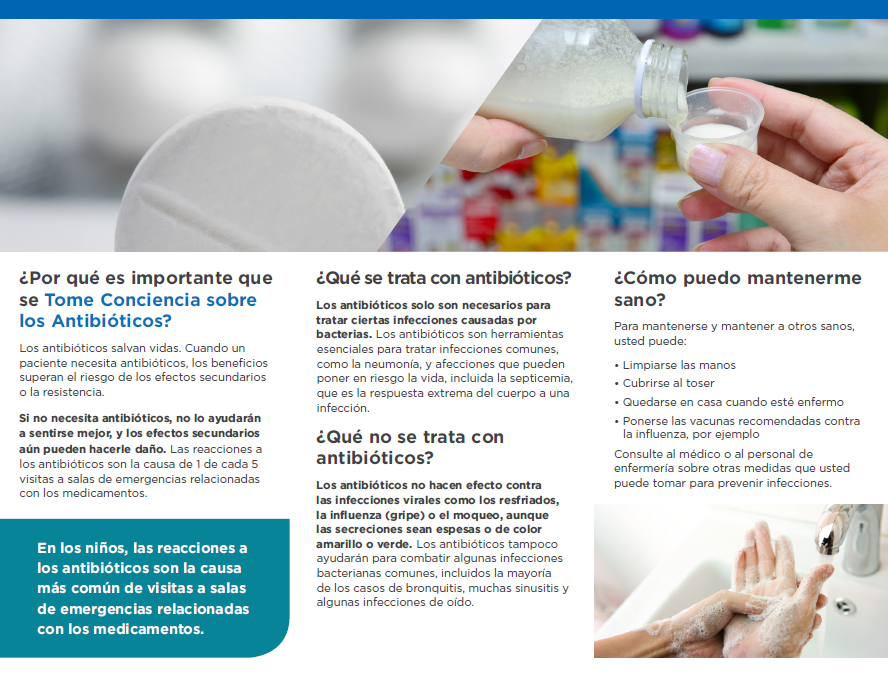
What’s your general reaction to the way this brochure looks? (HMTS 6e)
PROBE: What do you think about the layout of the information?
PROBE: What do you like about this brochure?
PROBE: How could this brochure be improved?
Is this brochure easy or difficult to read? Why? (HMTS 16e)
What do you think about the images? (HMTS 5e)
PROBE: Are they appropriate for this material? [If not] What is inappropriate and why?
PROBE: What, if any, images would be better? (HMTS 4e)
Placement of information
Where would you expect to see this material? (HMTS 64d)
If your healthcare provider gave this material to you, would you read it? (HMTS 61d)
PROBE: Why or why not?
Would another type of material with this information be more helpful? If so, what type and why would it be better?
PROBE: What about a poster for your doctor’s office?
PROBE: What about a message on the TV at the doctor’s office?
Risks of antibiotics – antibiotic resistance
Now we are going to look at specific sections in the brochure. Before you start to read the first section…
Have you heard of antibiotic resistance before?
PROBE: [If yes] What do you know about it?
PROBE: [If yes] Where did you hear about it?
Great. Thanks for that discussion. Now, take a minute to read this section, “Por qué tomar antibióticos causa restencia a estos medicamentos?” (give 1–2 minutes).

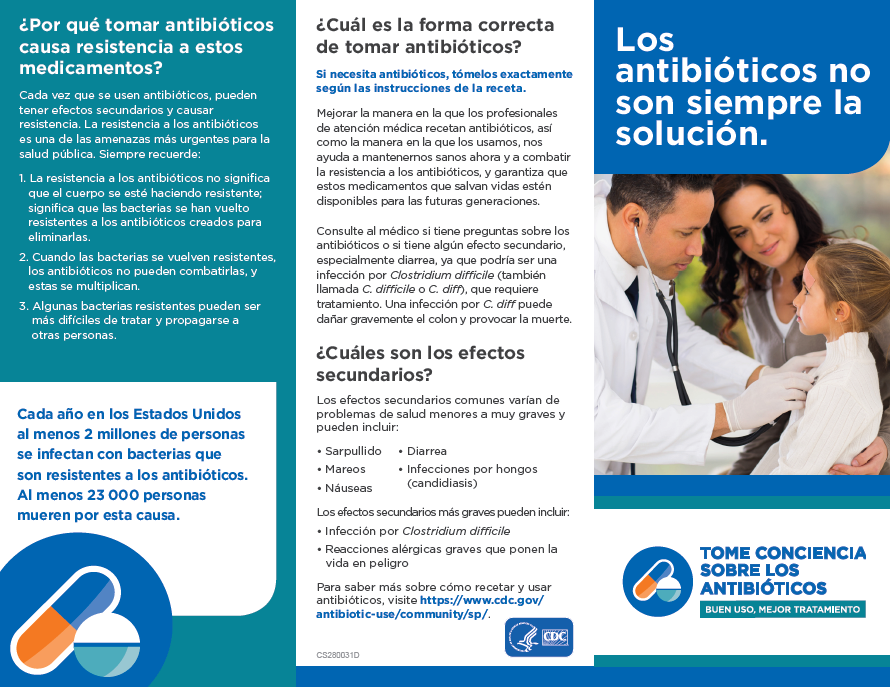
What would you say is the main message of this section? (HMTS 1d)
What information in this section, if any, is new to you? (HMTS 12d)
What information in this section, if any, is confusing, unclear, or hard to understand? (HMTS 6d)
How could the information in this section be improved? (HMTS 33d)
PROBE: What do you think about the amount of text?
Is there anything you want to know about antibiotic resistance that this section of the brochure doesn’t tell you? (HMTS 29d)
Risks of antibiotics – side effects
Ok, let’s move on to the next section in this brochure. Before you start to read this section…
Do you think a person can have side effects from taking antibiotics?
PROBE: [If yes] What are the side effects that you know about?
Great. Thanks for that discussion. Now, take a minute to read this section called, “Cuáles son los efectos secundarios.” (give 1–2 minutes).


What would you say is the main message of this section? (HMTS 1d)
Are these new ideas or something you’ve heard before? (HMTS 12d)
PROBE: Have you heard the term C. difficile or C. diff before?
PROBE: [If they say yes to probe above] Where did you hear it?
PROBE: What do you know about it?
What information in this section, if any, is confusing, unclear, or hard to understand? (HMTS 6d)
How could the information in this section be improved? (HMTS 33d)
PROBE: What do you think about the amount of text?
What, if anything, do you want to know about side effects of antibiotics that this section of the brochure doesn’t tell you? (HMTS 29d)
Now, let’s take a couple of minutes to look at these two sections side by side. I want you to focus on these concepts—not the words or images on these materials.
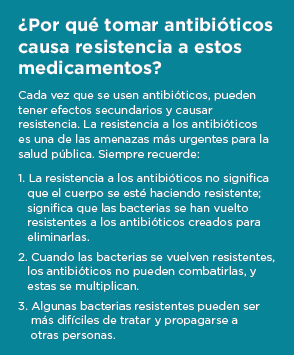
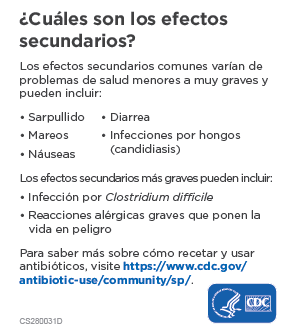
Which concept –antibiotic resistance or antibiotic side effects– is more likely to motivate you to take antibiotics only when you need them? (HMTS 110d)
PROBE: Why?
[For the concept that the participant didn’t identify as motivating] Why is this concept less likely to motivate you? (HMTS 120d)
PROBE: Can you suggest any changes to make it more effective?
Tagline
Now let’s take a look at the logo/tagline located in the bottom, right corner of the first page of the brochure.


What does the name “Tome Conciencia Sobre Los Antibioticos” mean? What is this telling you?
PROBE: What do you think about the length of the name? Is it too long? Too short?
What does this tag line “Buen Uso, Mejor Tratamiento” mean? What is this telling you?
PROBE: [If participants indicate the name/tagline isn’t translated to mean what it’s intended to mean] What changes do you recommend to make the campaign name/logo more clear?
TESTING VIRAL ILLNESSES PRESCRIPTION PAD [10 MINUTES]
We are going to move on to our last material. … Let’s say you’re sick and went to see your doctor. Your doctor says you have a cold, so you don’t need an antibiotic and gives you this symptom relief information.
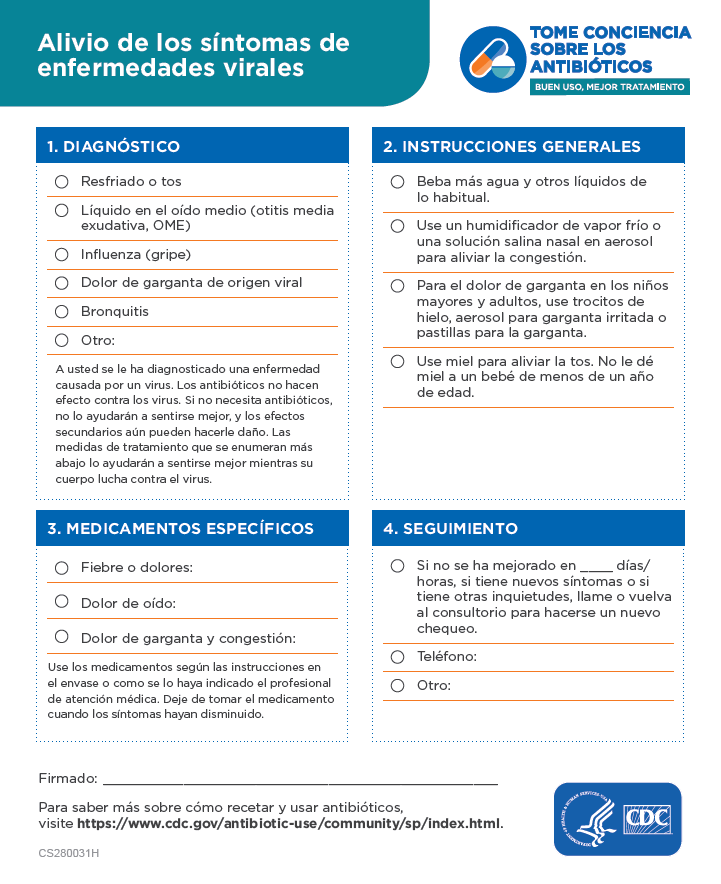
https://www.cdc.gov/antibiotic-use/community/pdfs/Rx-Pad-Symptom-Relief-small-Spanish-508_1.pdf
This document is currently blank, but it’s intended for your doctor to fill it in with instructions for relieving the symptoms of your specific illness. Based on this scenario, your doctor would
Check “cold or cough” under the diagnosis section.
Then, they may check “drink extra water and fluids” and “Use honey to relieve cough” under the general instructions section.
Under the specific medicines section, they will write in the medications and dose for sore throat and congestion.
Your doctor will add any follow-up instructions in section four.
Now, please take a minute to read it before we discuss it. [give 2-3 minutes to review]
How would you feel if your doctor gave you this symptom relief information after explaining that you didn’t need antibiotics for your cold?
PROBE: Why (for positive or negative response)?
PROBE: Based on the above scenario, would you be more satisfied with your visit to your doctor if you were provided this written symptom relief information? Why? (for positive or negative response)?
PROBE: If you went to a pharmacy for help treating a cold, would it be helpful to get this material from a pharmacist? Why or why not?
Is this information helpful?
PROBE: Why (for positive or negative response)?
What’s your general reaction to the way this symptom relief document looks? (HMTS 6e)
PROBE: What do you think about the layout of the information?
PROBE: What do you like about this document?
PROBE: How could this document be improved? (HMTS 33d)
Were there any words that were unusual or unfamiliar? (HMTS 4d)
PROBE: [If yes], which words are unusual or unfamiliar to you?
Is there anything you want to know about symptom relief for illnesses when antibiotics aren’t needed that this document doesn’t tell you?
PROBE: What about information about your specific illness/infection (referencing the cold in the hypothetical scenario)?
CLOSING [10 MINUTES]
This has been really great – thank you so much for sharing your thoughts and opinions. Do you have any comments or questions about the materials that you’d like to bring up before we end our discussion?
[After comments/questions are addressed] Let me step out for a moment and check in with my team to see if there are any additional questions before I invite a CDC expert in to answer any question you may have.
[Ask question if project team had any. After or if there are no questions, invite CDC expert in and introduce them for QA.]
Thanks for those questions. I hope you found the information helpful. I will go ahead and conclude our discussion now. Please visit www.cdc.gov/spanish/especialesCDC/antibioticos/ for more information on appropriate antibiotic prescribing. Thanks so much again for your participation.
Public reporting burden of this collection of information is estimated to average between 5 and 75 minutes per response, including the time for reviewing instructions, searching existing data sources, gathering and maintaining the data needed, and completing and reviewing the collection of information. An agency may not conduct or sponsor, and a person is not required to respond to a collection of information unless it displays a currently valid OMB Control Number. Send comments regarding this burden estimate or any other aspect of this collection of information, including suggestions for reducing this burden to CDC/ATSDR Reports Clearance Officer, 1600 Clifton Road NE, MS D-74, Atlanta, Georgia 30333; ATTN: PRA 0920-0572
| File Type | application/vnd.openxmlformats-officedocument.wordprocessingml.document |
| Author | Wiedeman, Kathryn (CDC/OID/NCEZID) |
| File Modified | 0000-00-00 |
| File Created | 2021-01-15 |
© 2026 OMB.report | Privacy Policy